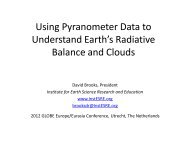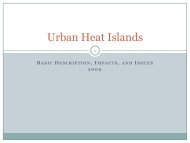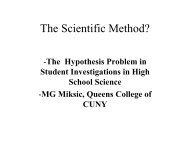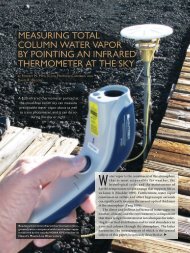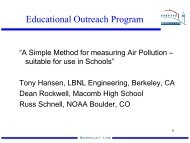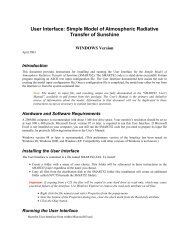Estimating Cloud Type from Pyranometer Observations - American ...
Estimating Cloud Type from Pyranometer Observations - American ...
Estimating Cloud Type from Pyranometer Observations - American ...
You also want an ePaper? Increase the reach of your titles
YUMPU automatically turns print PDFs into web optimized ePapers that Google loves.
JANUARY 1999 DUCHON AND O’MALLEY<br />
135<br />
particularly if a single cloud element persists between<br />
the pyranometer and the direct beam for the entire span<br />
of the window width. A much larger window, say 50<br />
min, is also inappropriate because different cloud types<br />
may occur during this period of time. Based on experiments<br />
with various window lengths, 21 min appears to<br />
be a reasonable time span for estimating the mean and<br />
variance.<br />
b. Decision criteria<br />
Figure 5 shows the decision criteria for each of the<br />
seven cloud types. The determination of cloud-type<br />
boundaries is based primarily on a comparison of human-observed<br />
cloud types coincident with the measured<br />
irradiance parameters at the ARM CART site and secondarily<br />
on nominal values of the two parameters intuitively<br />
expected for the different categories based on<br />
the standard cloud-type descriptions. Thus the rectangular<br />
boundaries should not be considered as precise<br />
delineations.<br />
The lower-left-hand side of Fig. 5 contains stratus,<br />
precipitation, and fog. Here the attenuation of solar radiation<br />
is high, and the variability in the irradiance signal<br />
is small. The large area of cumulus is bounded on<br />
the left by a ratio of scaled observed to scaled clearsky<br />
irradiances of 0.5 and on the bottom by a standard<br />
deviation of scaled irradiance of about 120 W m 2 ,<br />
which is 20 W m 2 higher than the upper-stratus boundary.<br />
In addition, there must be at least one value of the<br />
21-min time series that has an irradiance greater than<br />
the clear-sky value, as is typical of cumulus clouds (see,<br />
for example, Fig. 3). This criterion was used to separate<br />
cumulus <strong>from</strong> cumulus and cirrus, the other large rectangle<br />
in Fig. 5. The argument is that cirrus added to<br />
cumulus lowers the general level of irradiance relative<br />
to clear-sky irradiance to such a value that the above<br />
criterion is not met. Nevertheless, the cumulus contribution<br />
continues to yield large variance.<br />
Cirrus occupies an area with the ratio of irradiances<br />
varying <strong>from</strong> 0.8 to 1.05. A ratio greater than unity is<br />
again due to scattering of the solar beam, this time by<br />
patchy cirrus clouds. The standard deviation is low because<br />
of the thinness of the clouds and limited attenuation. The<br />
clear-sky area is defined by an irradiance ratio extending<br />
<strong>from</strong> 0.88 to 1.05 and a standard deviation of scaled irradiance<br />
less than 10 W m 2 . The area outside specific<br />
cloud types represents clouds of indeterminate types.<br />
The seven cloud types are shown on the left-hand<br />
side of Table 1. On the right-hand side are the associated<br />
human observations considered acceptable as verification.<br />
In section 5 these relationships will be used to<br />
compare the objective cloud classification with the human<br />
observations for 1995.<br />
4. Clear-sky irradiance model<br />
a. Formulation<br />
<strong>Estimating</strong> clear-sky solar radiation is one of the primary<br />
ingredients of the pyranometer method. The model<br />
used here is that developed by Meyers and Dale (1983).<br />
The fundamental assumption in this model is that the<br />
formulas for transmission of solar radiation through the<br />
atmosphere as developed, for example, by Iqbal (1983),<br />
for a single wavelength, can be applied to the entire<br />
solar spectrum. In the absence of clouds, the surface<br />
irradiance I is given by<br />
I I 0 cos z T R T g T w T a , (1)<br />
where I 0 is the irradiance at the top of the atmosphere<br />
normal to the solar beam; z is the solar zenith angle;<br />
and the T i ’s are transmission coefficients for Rayleigh<br />
scattering (R): permanent gas absorption (g), water vapor<br />
absorption (w), and scattering by aerosols (a). Although<br />
(1) is generally valid for monochromatic radiation<br />
only, it has been widely used to represent broadband<br />
irradiance in the real atmosphere (Atwater and Ball<br />
1981). Here, I 0 varies according to time of year as given<br />
by Iqbal (1983). The solar zenith angle z is taken <strong>from</strong><br />
the standard expression given by List (1968, 497) and<br />
takes into account latitude, declination angle, and hour<br />
angle. The two angles are computed as a function of<br />
latitude, longitude, and day of year using an algorithm<br />
given by Michalsky (1988).<br />
The Rayleigh and permanent gas scattering and absorption<br />
transmission coefficients are taken <strong>from</strong> Kondratyev<br />
(1969) and Atwater and Brown (1974) and given<br />
by<br />
5 0.5<br />
TT R g 1.021 0.084[m(949p 10 0.051)] ,<br />
(2)<br />
where p is surface pressure (kPa) and m the optical<br />
airmass number at 101.3 kPa given by<br />
m 35(1224 cos 2 z 1) 0.5 . (3)<br />
The water vapor transmission coefficient is<br />
T w 1 0.077(um) 0.3 , (4)<br />
where u is precipitable water (cm) (McDonald 1960).<br />
Precipitable water is estimated <strong>from</strong> the surface dewpoint<br />
(Smith 1966) using<br />
u exp[0.1133 ln( 1) 0.0393T d ], (5)<br />
where T d is the local average daily dewpoint (F) and<br />
is an empirically derived constant based on season<br />
and latitude (Table 2.1 in Smith 1966). The aerosol<br />
transmission coefficient was determined by Meyers and<br />
Dale (1983) as a residual in clear-sky studies and is<br />
given by<br />
T a x m , (6)<br />
where x 0.935 was found to be nearly constant for<br />
continental midlatitude stations.<br />
b. Comparison with observations<br />
Figure 6 shows the percentage difference between<br />
modeled [Eq. (1)] and measured clear-sky irradiance<br />
given by





